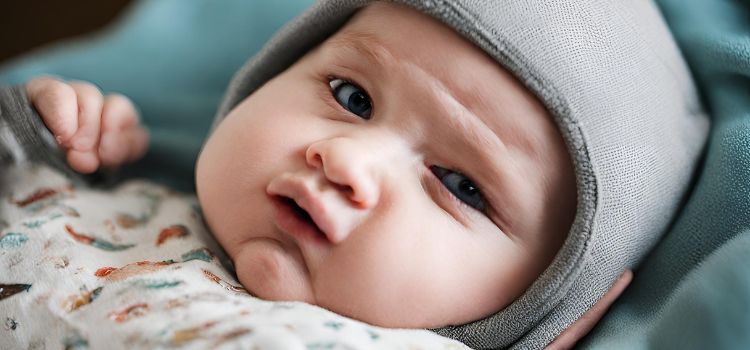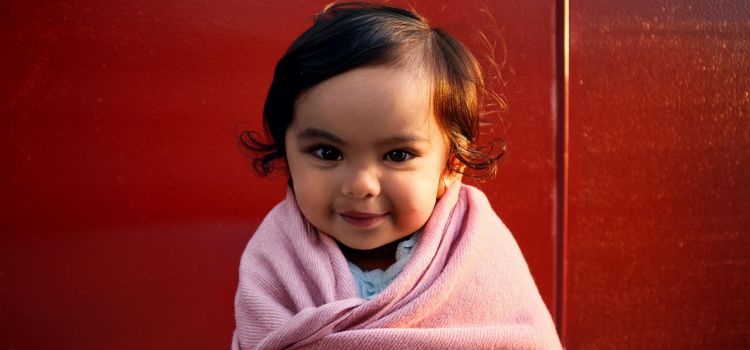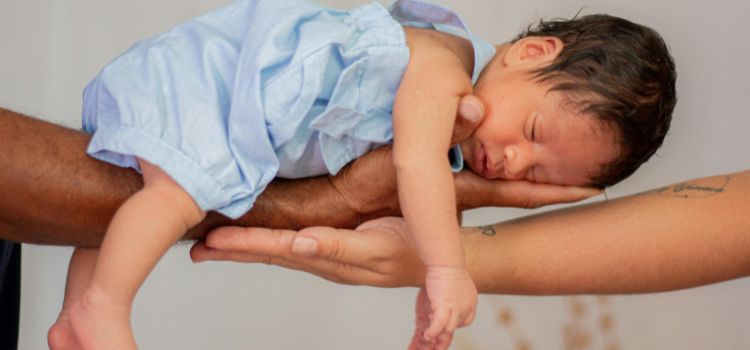To bed with a fever, dress your baby in lightweight, breathable clothing that keeps them comfortable. A soothing, loose-fitting cotton pajama or onesie is ideal as it allows heat to escape and prevents overheating.

You can add an extra layer like a thin blanket or a sleep sack if needed, but ensure it’s not too heavy or restrictive for the baby’s movement. Additionally, consider keeping the room temperature cool and ensuring proper ventilation to aid in fever management.
Now let’s delve into this matter of what should my baby wear to bed with a fever with some essential tips to focus on.
Importance Of Choosing The Right Clothing
Choosing the right clothing is crucial when it comes to dressing your feverish baby for bed. Prioritize comfort with loose, breathable fabrics to promote better sleep and help regulate their body temperature. Remember, the right clothing can make a difference in their rest and overall well-being.

Here we will discuss the factors to consider when choosing clothing for a feverish baby and why appropriate clothing can aid in managing fever symptoms.
Factors To Consider When Choosing Clothing For A Feverish Baby
- Material: Opt for lightweight and breathable materials like cotton or bamboo, which can help regulate your baby’s body temperature and prevent overheating.
- Comfort: Choose clothing that is soft, loose-fitting, and comfortable to wear. Avoid tight-fitting or restrictive clothing that may cause discomfort or irritate your baby’s skin.
- Layering: Consider dressing your baby in layers so that you can easily adjust their clothing according to their body temperature. Layering allows you to add or remove clothing as needed without disturbing your baby’s sleep.
- Easy access: Select clothing with easy access for frequent temperature checks and medication administration. Look for designs with snaps or buttons that make it convenient to access your baby’s chest or back when needed.
Why Appropriate Clothing Can Aid In Managing Fever Symptoms
- Regulation of body temperature: Choosing the right clothing can help regulate your baby’s body temperature, preventing overheating or excessive cooling. This can contribute to better fever management and overall comfort.
- Soothing and relaxation: Comfortable clothing can help soothe your baby and promote relaxation, allowing them to rest more comfortably during their illness.
- Facilitates medication administration: Clothing with easy access makes it easier to administer medication or use a fever-reducing method like cold compresses on your baby’s body. This can help in managing the fever and providing relief.
- Minimal disruption during sleep: Well-chosen clothing ensures that your baby’s sleep is not interrupted due to discomfort or excessive heat. This uninterrupted sleep plays a vital role in their recovery process.
When your baby has a fever, selecting the right clothing is important for their comfort and well-being. Considering factors like material, comfort, layering, and easy access will help you choose appropriate clothing that aids in managing their fever symptoms.
By paying attention to their clothing choices, you can help provide a more comfortable environment for your little one as they recover.
Recommended Fabrics For Feverish Babies
Find the perfect fabrics to keep your feverish baby comfortable at night. Opt for lightweight, breathable materials like cotton or bamboo to help regulate body temperature and promote a good night’s sleep.

The Best Fabrics For Regulating Body Temperature
When your baby has a fever, it’s crucial to choose the right fabrics for their bed to help regulate their body temperature. The right fabric can provide comfort and promote better sleep for your little one. Here are the recommended fabrics for feverish babies:
Natural fibers:
- Cotton: Cotton is a popular choice for baby clothes and bedding due to its breathability and softness. It allows air circulation, preventing overheating and promoting comfort.
- Bamboo: Bamboo fabric is gaining popularity due to its natural moisture-wicking properties, which help regulate body temperature. It is also incredibly soft and hypoallergenic, making it suitable for sensitive skin.
Moisture-wicking fabrics:
- Microfiber: Microfiber fabrics, specifically those made with polyester or nylon, can effectively pull moisture away from the skin, keeping your baby dry and comfortable throughout the night.
- Athletic fabrics: Fabrics commonly used in athletic wear, such as performance polyester blends, are designed to wick away moisture. They can be a great option for feverish babies as they help regulate temperature and keep the skin dry.
Thermal fabrics:
- Merino wool: Surprisingly, merino wool can provide excellent temperature regulation for feverish babies. It has natural cooling and insulating properties, keeping your baby warm when they need it and cool when the fever spikes.
- Flannel: Flannel is a soft and warm fabric that can help trap heat when your baby has chills. It provides insulation without causing overheating, making it suitable for feverish conditions.
Lightweight and breathable fabrics:
- Muslin: Muslin is a lightweight and breathable fabric known for its open weave. It allows air to flow freely, ensuring proper ventilation and preventing overheating.
- Jersey knit: Jersey knit fabrics, commonly used in baby clothes, are lightweight and breathable. They provide a comfortable and stretchy fit that allows air circulation.
Remember to choose fabrics that are gentle on your baby’s skin, hypoallergenic, and free from harsh chemicals. Pay attention to the fabric labels and opt for breathable and comfortable materials.
By selecting the right fabrics, you can help your little one stay comfortable and promote a better sleep environment during fever episodes.
Layering Techniques For Better Temperature Control
For better temperature control, learn layering techniques to dress your baby with a fever for bed. Ensure comfort and adjust layers based on their needs for a restful night’s sleep.

Having a fever can make your little one feel uncomfortable and restless, especially when it’s time for bed. As a parent, you may wonder what your baby should wear to bed to ensure they stay comfortable and maintain the right body temperature throughout the night.
Layering clothing can be a great technique to provide optimal comfort and flexibility for your baby while allowing easy access for temperature monitoring and medication administration. Let’s explore how to layer clothing effectively in this section.
How To Layer Clothing To Provide Optimal Comfort And Flexibility
- Start with a lightweight, breathable base layer: Opt for a cotton onesie or pajamas as the first layer to provide a comfortable and soft touch against your baby’s skin. Cotton is a natural fabric that allows for better air circulation and helps regulate body temperature.
- Add a middle layer for insulation: Depending on the room temperature, you can add a layer of clothing for extra warmth, such as a long-sleeved pajama set or a sleep sack made of fleece or a similar material. This layer helps trap body heat and keeps your baby cozy without overheating.
- Use a lightweight, breathable outer layer: To maintain flexibility and avoid overheating, choose a light blanket or sleep sack made of breathable material, like cotton or muslin. This outer layer provides an extra layer of insulation while allowing for airflow to prevent your baby from becoming too warm.
- Consider the ambient room temperature: Adjust the layers based on the room temperature, as this can impact your baby’s comfort level. If it’s particularly chilly, you may need to add thicker layers or use a warmer sleep sack. On warmer nights, opt for lighter and more breathable layers to prevent overheating.
- Be mindful of your baby’s preferences: Every baby is different, and some may be more sensitive to temperature changes than others. Pay attention to cues from your little one, such as sweating or feeling cold to the touch. Adjust the layers accordingly to ensure they are neither too hot nor too cold.
Ensuring Easy Access For Temperature Monitoring And Medication Administration
- Opt for layering options with easy access: Look for clothing items or sleep sacks with snap buttons or zippers that allow quick access to your baby’s temperature check or administer medication when needed. This ensures minimal disturbance to their sleep while allowing you to monitor their fever and provide necessary care.
- Choose clothing with open necklines: When layering, consider selecting clothing items with open necklines to facilitate easy temperature monitoring, particularly if you need to use a forehead or ear thermometer. Open necklines make it easier to access your baby’s forehead or ear without needing to remove multiple layers.
Layering clothing for your baby with a fever not only provides comfort and flexibility but also allows easy access for temperature monitoring and medication administration. By following these layering techniques, you can ensure your little one stays cozy and has a restful night’s sleep while recovering from their fever.
Remember to adjust the layers based on the ambient room temperature and your baby’s individual preferences. Stay attuned to their comfort and make any necessary adjustments accordingly.
Frequently Asked Questions Of What Should My Baby Wear To Bed With A Fever
What Kind Of Clothes Should My Baby Wear To Bed With A Fever?
During a fever, it’s important to dress your baby in lightweight, breathable fabrics that help regulate their body temperature. Opt for loose-fitting cotton pajamas that allow airflow and help prevent overheating. Avoid using too many layers or heavy blankets, as this can make your baby uncomfortable and exacerbate their fever.
Should I Dress My Baby In Extra Layers When They Have A Fever?
No, it’s important not to overdress your baby when they have a fever. Adding extra layers can increase their body temperature and make them feel even hotter. Stick to light and breathable clothing, and monitor their body temperature regularly to ensure they stay comfortable.
What Should I Do If My Baby Feels Cold With A Fever?
If your baby feels cold with a fever, you can add a lightweight blanket or increase the room temperature slightly. However, be cautious not to overdress them, as this can cause them to overheat. It’s important to strike a balance and ensure they are neither too hot nor too cold.
Can I Use A Fan Or Air Conditioning To Cool My Baby With A Fever?
Yes, you can use a fan or air conditioning to help cool your baby with a fever. Just make sure the fan or air conditioning is not blowing directly on them, as this can cause them to become chilled. Position the fan or adjust the air conditioning to maintain a comfortable room temperature for your baby.
Conclusion
It is crucial to dress your baby appropriately for bed when they have a fever. Opt for lightweight and breathable fabrics to prevent overheating. Avoid bundling them up in too many layers, as this can exacerbate their fever and make them uncomfortable.
Instead, dress them in a single layer of clothing and adjust based on their body temperature. Keep their bedroom cool and well-ventilated to maintain a comfortable sleeping environment. Additionally, keep an eye on their fever and monitor any changes in their condition.
If their fever persists or worsens, seek medical advice from a healthcare professional. Remember, the goal is to keep your baby comfortable and promote restful sleep during this time. By following these guidelines, you can ensure your baby’s comfort and help them get the rest they need to recover.
Leave a Reply